All animals, including humans, go through changes, including biochemical, physiological, morphological, and anatomical changes. Changes continue throughout our lives as cells die and replicate, and as age morphs our bodies. But with most animals, changes are slight and often imperceptible. A lot of changes are hormonal and chemical shifts that affect development and growth.
And then there’s metamorphosis.
Metamorphosis is a biological process that involves an abrupt change in an animal.
The word “metamorphosis” is Greek, and it means to change or transform in shape. It entails an immature form transitioning into adulthood in distinct stages — going from one type of life form to a completely different one.

Butterflies slowly flap their wings after emerging from their chrysalis in order to supply their newly-formed appendages with blood flow.
©iStock.com/NirutiStock
Metamorphosis Explained
Unlike the typical subtle developments in animals, metamorphosis is dramatic. It’s controlled by the release of hormones in the cells. Mammals usually move from adolescence to adulthood and old age gradually, maintaining their form and shape. However, in metamorphosis, an animal moves through those stages and changes from one form or shape to another.
Metamorphosis occurs in animals such as amphibians, insects, and fish. The most common (and popular) examples of metamorphosis are the transformation of a tadpole to a frog and a caterpillar to a butterfly. But there are certainly other animals that go through a metamorphosis that have equally interesting stories. In this article we concentrate on the following five:
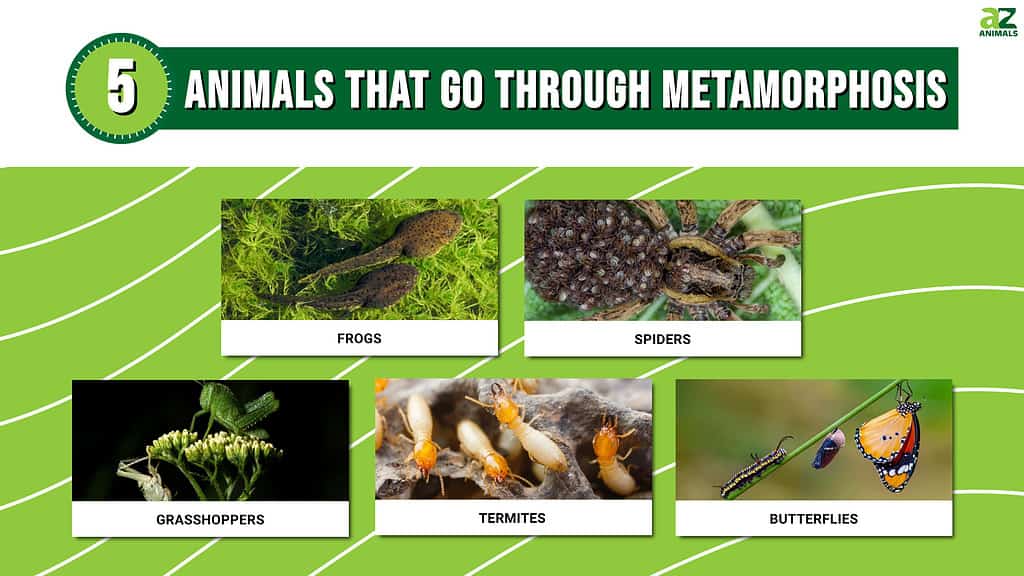
Read on to discover some fascinating details about these animals that go through metamorphosis and how they do it!
#5 Butterflies
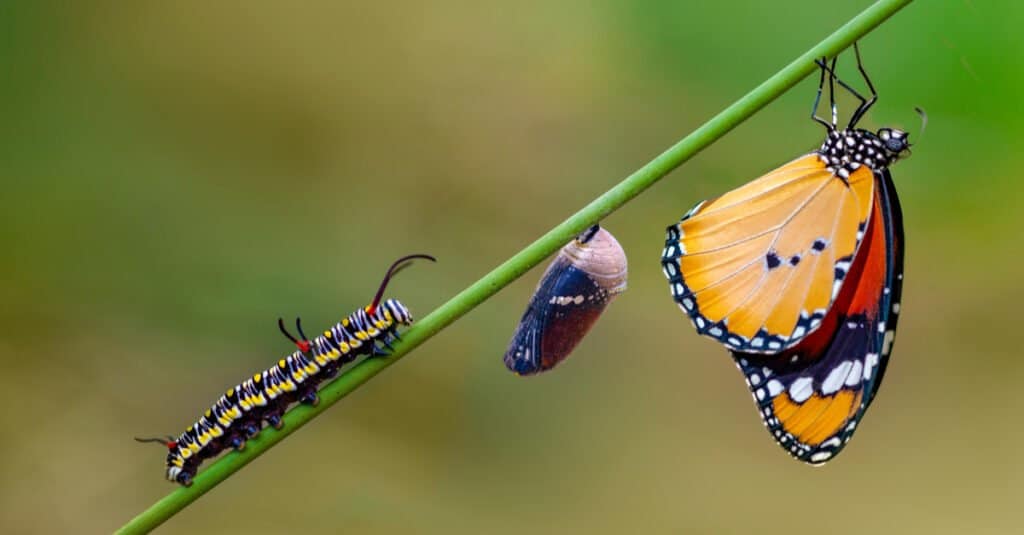
The life cycle of the butterfly is captivating. Here, we see three different stages of it.
©sezer66/Shutterstock.com
Butterflies are the adult stage of an insect belonging to a group called Lepidoptera, which is a Greek word meaning “scaly wings.”
The term is apropos, as the wings of these insects have thousands of overlapping tiny scales. They give the butterfly its stunning appearance as the scales are set in colorful patterns unique to their species.
Butterflies have the typical body of insects: head, thorax, abdomen, and six legs. They also have an exoskeleton and two antennae.
The first stage of butterfly life is the ovum or egg. These shells are tiny and can be cylindrical, round, or oval. Females attach eggs to plant stems or leaves, which serve as food when the larvae hatch.
In the second stage, the larva/caterpillar hatches. The new animal may have a number of legs. Several pairs will be true legs but some will be false legs (prolegs). The caterpillar has a voracious appetite and spends most of its life eating. It grows a lot during this phase, only the outer skin doesn’t grow along with the rest of its body. Outgrowing its skin, the caterpillar molts, shedding one exoskeleton and replacing it with another. Caterpillars may go through up to five molts.
The third stage is the chrysalis or pupa. Caterpillars find a twig and make it home. (They may use a wall or other support.) The exoskeleton splits and reveals the chrysalis. The chrysalis shell hangs like a sack.
Inside the shell, the caterpillar breaks down. It rearranges its structure, growing a new body, legs, and wings. Unlike the caterpillar, the pupa doesn’t eat. It survives on energy from food eaten during the larval stage. This third step can last from several days to twelve months.
The final stage is the birth of the adult butterfly. The chrysalis splits, and the butterfly emerges.
Most adult butterflies live a week or two. Some species live as long as 18 months.
#4 Termites
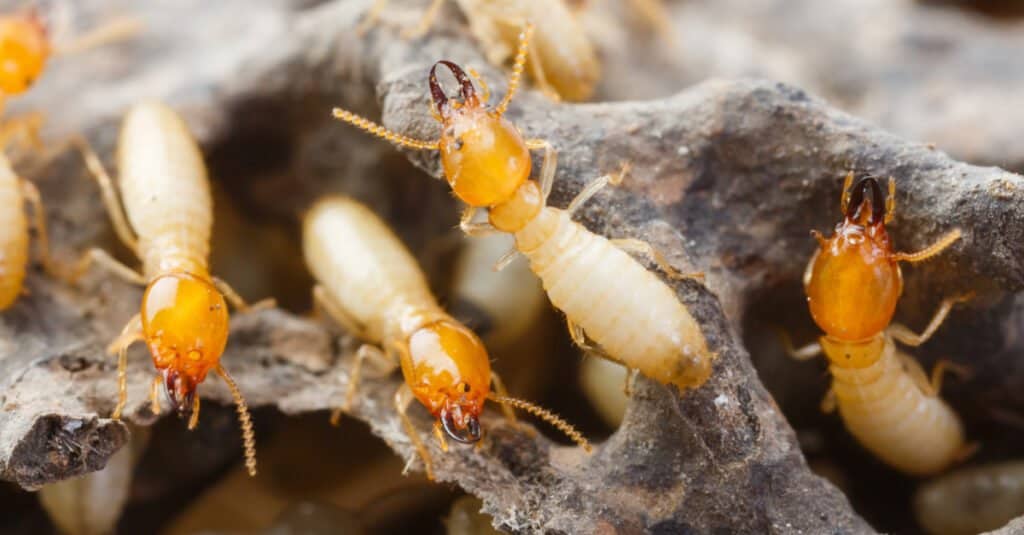
Undergoing incomplete metamorphosis, termites have three stages: egg, nymph, and adult.
©7th Son Studio/Shutterstock.com
While found all over the world and in any environment, the majority of termites live in rainforests.
Termites undergo what’s called “incomplete metamorphosis.” This differentiates their life cycle from eusocial insects like ants, wasps, and bees. In complete metamorphosis, the juvenile hatches and goes through a series of molts and growths with each stage until it becomes an adult. With incomplete metamorphosis, on the other hand, the changes appear more gradually.
Termites bear a strong resemblance to the adult workers that watch over them, and the worker termite’s metamorphosis comes in three stages:
- Egg
- Nymph
- Adult.
The egg cycle ends after about four weeks, the nymph stage lasts at least a month (though it depends on the climate), and adult stages run from one to several years. The entire process can vary from species to species and change based on the ecosystem.
The nymphs are mobile, especially in advanced stages. They’re not ready to work, but they move about the nest freely. The nymph can go through up to seven molts but does not molt in solitude. Adult workers chew on and help them shed their outer skin. Some species, like the damp-wood or dry-wood termite, can molt with no assistance.
Castes in the colony originate during the worker instar, and the termite population is consistent with their pheromones and food supply. For example, there are always a certain number of soldier termites. If there were a war and all of the soldier termites died, the pheromone imbalance would restore the population balance.
While termites can live a decade, their average lifespan is 1–5 years.
#3 Grasshoppers

In roughly two months, grasshoppers morph from an egg to an adult.
©Albie Venter/Shutterstock.com
There are an estimated 11,000 to 12,000 species of grasshoppers. Large grasshoppers can leap 20 times the length of their bodies. Grasshoppers can grow between two and five inches, and the females are typically larger than the males.
Grasshoppers pass through several nymph stages. The young grasshopper hatches in an adult form, and the external skeleton morphs during growth.
Grasshoppers, too, go through an incomplete metamorphosis process. It takes about two months for the animals to go from egg to adult.
Adult females lay eggs throughout the summer and fall, and the eggs stick together, forming a pod. Depending on the species, pods can consist of a few eggs or several hundred. Females bury the pods to keep them safe.
The nymph stage is the next phase. After hatching, nymphs survive on soft and succulent plant foliage. Nymphs closely resemble adult grasshoppers. During this step, the grasshopper will shed five to six times, and the molting leads into the adult stage.
This phase can last up to six weeks, at which point the creature is mature. The lifespan of the adult is around one year. The adult female immediately starts laying eggs, which is a process she’ll continue doing throughout her lifespan, laying eggs every three to four days.
#2 Spiders
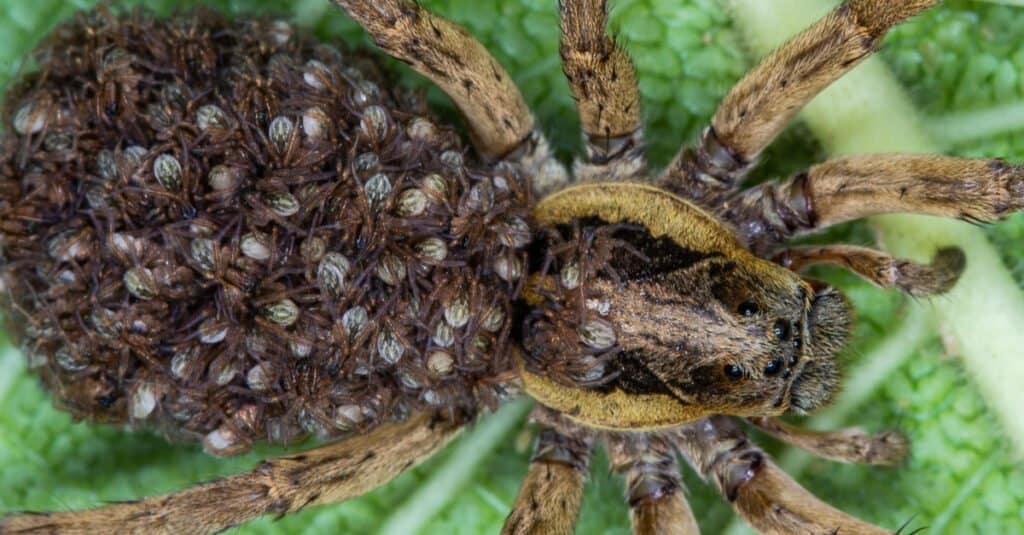
The mother Wolf Spider carries her newly hatched spiderlings on her back after they emerge from their sac.
©Andrew Ring/Shutterstock.com
Spiders go through an incomplete metamorphosis. The three complete growth stages are:
- Egg
- Spiderling
- Adult.
There’s no pupal stage with arachnids — the spiderlings look like smaller versions of the adult. With spiders, the exoskeleton doesn’t grow, so the spider has to shed or molt its exoskeleton several times.
Most spiders drop eggs into silken sacs. Some species may secure their sacs in a web, or attach them to leaves or twigs. Others carry the sac until the eggs hatch. There are even young spiderlings that cannibalistically eat their own kind.
The embryonic stage is the production and storage of the egg. Some spiders in temperate ecosystems overwinter in the sac, and mothers guard the egg sacs against predators.
In a unique move, female wolf spiders carry the sac and, when it’s time, bite it open to free their spiderlings. The young may then spend over a week atop the mother’s back.
The spiderling stage is the immature phase. Once hatched, they disperse right away. Some walk, and others may balloon. “Ballooning” is a tactic that spiders use to travel great distances. They climb and perch on an object. Raising their abdomens, they spin silk threads that catch the wind and carry them away. Studies reveal that, in some cases, they can travel several miles.
As they grow, spiders molt repeatedly. After shedding, they’re extremely vulnerable, and they are carefully guarded by their mother.
Spiders live an average of one to two years. In adulthood, spiders mate and repeat the life cycle. Females tend to have longer lifespans. Males die usually after mating.
Tarantulas have unusually long lives. Females live up to two decades, and these spiders keep molting even after full maturity. Should the female tarantula molt after mating, she has to mate again as sperm storage and the exoskeleton eliminates the possibility of birthing new life.
#1 Frogs
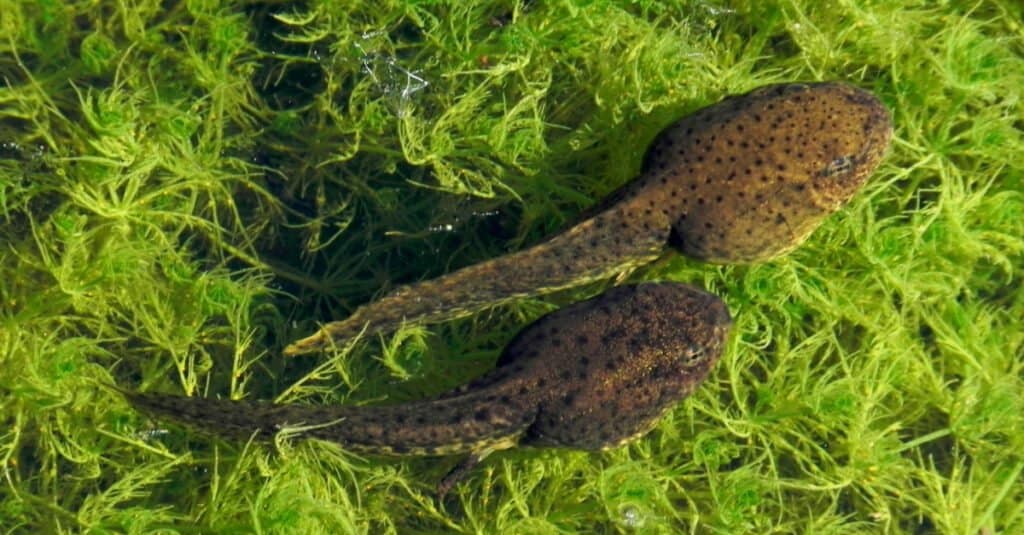
The tadpole gradually changes into its frog form.
©Joshua Ouellette/Shutterstock.com
The evolution of the frog is one of the most famous and popular forms of metamorphosis. The early stages of the life cycle revolve around eggs and tadpoles. Over the morphing period, lungs replace gills and limbs grow in as the tail disappears.
Frog eggs are released and left floating in a body of water, usually a pond. The egg cluster is an “egg mass.” There can be up to 4,000 eggs in one laying.
Tadpoles hatch and live in the water. Also called polliwogs, tadpoles are aquatic larvae. These creatures have oval, short bodies and broad tails, and there are no external gills. The operculum conceals the internal gills, which are like a small door that opens and closes.
The tadpole gradually turns into a froglet. The transformation includes amazing things like the growth of legs and arms. The body develops definition and the tail loses its silken covering. Soon, the tail shrinks. The lungs develop and the back legs continue to grow until the transformation is complete. When they shed skin, frogs consume some or all of it.
Is It Normal for Animals to Go Through Metamorphosis?
We have covered five different examples of animal metamorphosis in this article — but there are many other interesting examples! Dragonflies, scorpions, salamanders, mayflies and beetles are among this group. Sea creatures such as crustaceans (lobster, crabs, prawns) and cnidarians (jelly fish, sea anemones) and echinoderms (starfish, sea urchins, sea cucumber) also undergo complete metamorphosis. Some studies estimate approximately 80% of all animals experience metamorphosis to some degree. This means it’s actually rarer for a creature not to transform its body in some way during its development.
Summary of 5 Animals That Go Through Metamorphosis
| Rank | Animal Name | Life Stages |
|---|---|---|
| 1 | Frog | Egg, Tadpole, Froglet, Adult Frog |
| 2 | Spider | Egg, Spiderling, Adult |
| 3 | Grasshopper | Egg, Nymph, Adult |
| 4 | Termite | Egg, Nymph, Adult |
| 5 | Butterfly | Egg, Larva (Caterpillar), Pupa (Chrysalis), Adult |
The photo featured at the top of this post is © sezer66/Shutterstock.com
Thank you for reading! Have some feedback for us? Contact the AZ Animals editorial team.






